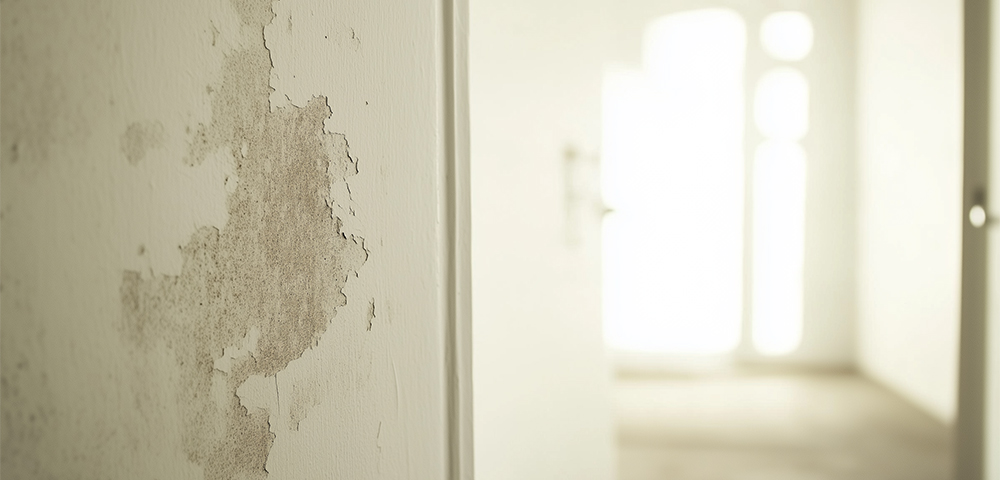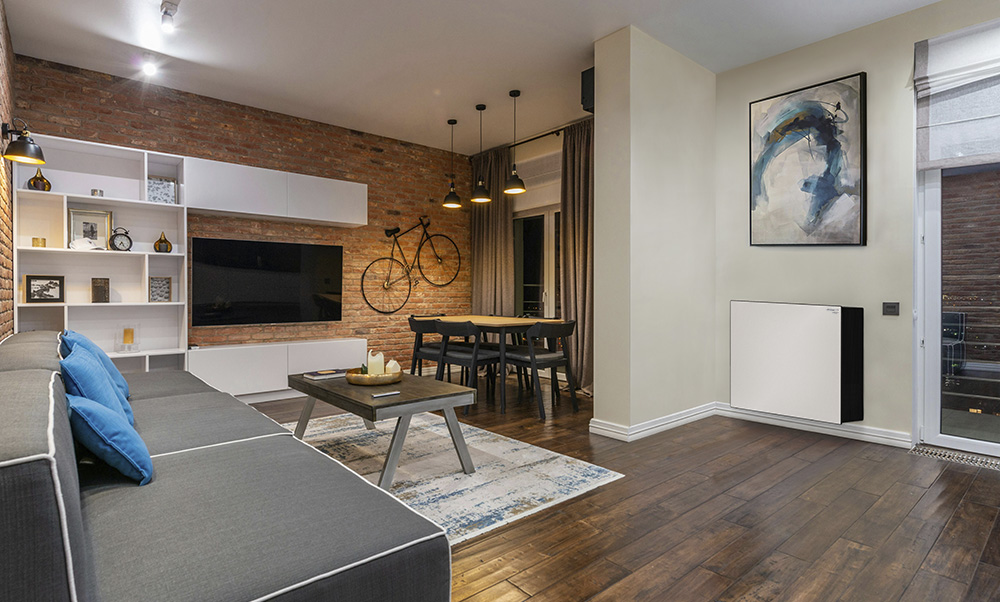In homes that are increasingly well insulated, the HRV (Heat Recovery Ventilation) system is a real game changer! It is not a luxury, but a technology designed to ensure well-being and health in every room.
Opening a window to change the air is not enough: the change in air volume is not effective and, above all, the outside air is often full of pollutants. Today, we need a system that can manage air quality continuously and intelligently.
HRV does not just let air into the house: it filters it, recovers heat by exchanging it between the incoming and outgoing air flows and distributes it evenly. It is a system that operates 24 hours a day, improving the healthiness of the environment. It is a silent but extremely important technology. It is essential to understand why and how it works: heat recovery ventilation systems are set to become a constant feature in the homes of the future.
Mould: the silent enemy of energy-efficient homes
Highly sealed windows, thermal insulation and total insulation: all this has made modern homes more energy efficient. But what is one of the most disadvantageous consequences? Stagnant humidity, condensation and mould proliferation. A hidden problem, but one that is worrying for both our health and that of the property.
Mould releases spores that disperse into the air and can cause allergic reactions, respiratory problems, headaches and fatigue. In severe cases, they can even lead to chronic diseases.

The HRV system prevents mould thanks to air exchange
HRV is not a dehumidifier or an extractor fan. Dehumidifiers remove moisture. Extractor fans move air. But only HRV combines constant ventilation, heat recovery, humidity control and air filtration.
Thanks to dedicated sensors and intelligent technology, HRV automatically regulates the extraction of stale air and the intake of clean air, maintaining the right balance between temperature and humidity.
Indoor allergens and pollutants: an invisible bomb
The air in our homes – especially in urban environments – is often worse than the air outside. According to the WHO, indoor pollution is often the most dangerous because it is what we are exposed to most of the time. CO2, VOCs, pollen, fine dust and mould spores accumulate in homes.
Everyday activities, cleaning products, furnishing materials and human presence itself generate pollutants. HRV is the only system capable of managing them continuously and automatically.
Sick building syndrome
Sick building syndrome (SBS) is a condition in which the occupants of a building experience a range of physical and cognitive symptoms that can be attributed to the indoor environment, without any specific cause being identified. The symptoms tend to improve or disappear when the occupants leave the building.
The most common symptoms include headaches, eye, nose and throat irritation, fatigue, difficulty concentrating, dizziness and nausea. The causes are often associated with poor ventilation, the presence of chemical pollutants (such as volatile organic compounds), fine dust, mould or unfavourable environmental conditions such as excessive humidity or inadequate lighting.
The phenomenon is mainly observed in modern buildings with centralised air conditioning systems and poor natural air exchange.
HRV eliminates the systemic causes of the problem, structurally improving the environmental quality.

Why HRV is still little known
Many professionals do not know it thoroughly, others underestimate it. A new HRV culture is needed!
Many people still associate heat recovery ventilation with the idea of a difficult and complicated system that is expensive to install and maintain.
This idea is partly linked to the first systems on the market, which were mainly intended for high-end properties or major renovations: in fact, those early systems required careful design work and installation that needed in-depth technical knowledge of the product, which very few installers had.
Today, thanks to genuine revolutions in product design (such as AriaSilent), installing an HRV is child's play, and it is just as easy for the user to control its parameters and operation. HRV is now a system that is affordable for everyone and suitable for any home, and it could not be otherwise, given the increasingly indispensable role it will play in the years to come.
Heat recovery ventilation systems are the only effective way to eliminate mould, condensation, carbon dioxide build-up and other harmful agents that can accumulate inside the home in concentrations that are harmful to both the occupants and the building itself.
HRV and new construction: a must
Heat recovery ventilation systems are essential for both energy class A homes and passive houses because they combine energy efficiency and indoor air quality - two key elements in both cases.
Class A homes are designed to minimise heat loss. This requires a large amount of insulation and a high level of airtightness. Without an HRV system, windows would need to be opened frequently to allow air to circulate, compromising the benefits of thermal insulation. HRV extracts stale air and brings in preheated fresh air, drastically reducing energy losses and maintaining constant comfort and health.
Passive houses are based on the principle of eliminating almost all energy requirements for heating. This is only possible thanks to an extremely high-performance building envelope and the elimination of air leakage. In this context, HRV with heat recovery is indispensable: not only does it avoid the need to open windows, but it also recovers up to 90% of the heat from the outgoing air, contributing directly to maintaining optimal thermo-hygrometric conditions without the use of traditional systems.
HRV and renovation: the solution for existing buildings too
Centralised HRV systems (such as AriosaHV) require a dedicated space to house the machine and the distribution network pipes, which reach every room served by the system; systems of this type can only be installed during new construction or major renovation work.
However, there are also decentralised systems (such as AriosaDOT) that can be installed without any renovation work and effectively meet the needs of individual rooms. This makes it easy to equip any room with a heat recovery ventilation system without the need for any intervention (except for holes in the wall for air intake and extraction).

The breathing house is a myth to be dispelled
Houses do not breathe. In the past, buildings often had windows and doors that did not completely seal the envelope, and this factor could in some way (but fortuitously and problematically, often at the cost of enormous energy losses) contribute to transpiration. Today, however, this assumption is simply no longer valid. The building must be properly insulated, both for reasons of comfort and energy optimisation: consequently, a heat recovery ventilation system is essential for the home environment to be considered truly healthy.
Furthermore, as urbanisation rates continue to rise, access to a source of clean air is becoming increasingly important.
FAQ
What is the difference between HRV and air conditioning?
HRV manages air exchange and filtration. Air conditioning only regulates temperature and humidity.
Does the HRV system consume a lot of energy?
No, it is very efficient and consumes very little. It can be compared to a halogen light bulb.
Can I install HRV in a house that is already inhabited?
Yes, there are quick and non-invasive solutions that only require a couple of holes in a perimeter wall (e.g. AriosaDOT).
Does HRV also eliminate viruses and bacteria?
Yes, thanks to high-efficiency filters, the filtering capacity can also be effective against microscopic substances and particles.
How often should maintenance be carried out?
On average, every 3-6 months for the filters, plus an annual check, but this depends on the actual use of the machine and the air quality.
 Italiano
Italiano
 English
English
 Deutsch
Deutsch
 Français
Français
 Español
Español
 Greek
Greek